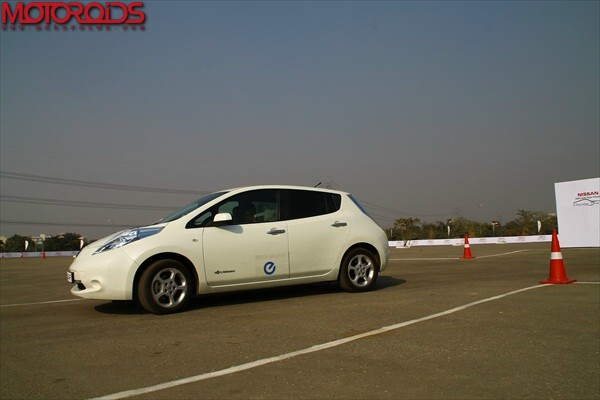
Photographs : Nitin Gupta
As part of its Auto Expo 2012 Preview, Nissan Motor India organized a media drive of all its prominent car models. The lineup comprised of all the Nissan car models available in India, along with the formidable GT-R and the zero emission Leaf.
While it was a pleasure to be able to drive all the Nissan cars at one place, we were particularly interested in getting our hands behind the wheel of the Leaf, widely considered the first ‘practical’ electric car in the world. With a range of about 175km, an 80% charge time of 30 minutes, quick acceleration and a spacious interior, the Leaf is currently the most acclaimed green car in the world. Having won the World car of the Year and European Car of the Year Awards for the year 2011, the LEAF has only substantiated its environmentally friendly credentials.
The LEAF, or Leading, Environmentally friendly, Affordable, Family car, considered the world’s first practical, full-size, zero emission electric car boasts many firsts in EV technology. The salient points of the car are listed below. A detailed video review of the car will follow this post.
• Not a concept but a full production car
• Already on sale in Japan, North America and Europe
• Award winner: LEAF is the 2011 World and European Car of the Year
• Lively performance and a range of up to 175km between charges
• 80 per cent quick charge capability in 30 minutes
• Five star safety rating
• Fully equipped with satellite navigation, parking camera and smart phone connectivity
• 108bhp Peak power, 280 Nm peak torque
• Top speed of upto 150km/h
• Rapid acceleration and good top speed
• Eco mode for extended range
• Charge stations located on maps
• Special app for Android, iOS and several other platforms
• Range indicator which shows the close range areas in white, farther areas which may turn out to be tricky range wise in light grey and depleted charge areas in dark grey
• Based on your driving style, en electronic display shows the number of trees you have saved. The most eco friendly drivers can save upto 5 trees. It doesn;t have to do anything with the trees in the real world, it’s a sort of star rating system for your eco-friendly driving skills.
• The LEAF is priced at $35000 in the US, which translates to about Rs 18 lakh in India. After import duties the car should not cost anything less than 30 lakh, making it quite unviable for this market.
• It can, however, be brought as a technology showcase. Film stars and millionaires will love to have one parked in their garages which would bring in good publicity for Nissan, which is a relatively new brand in India.
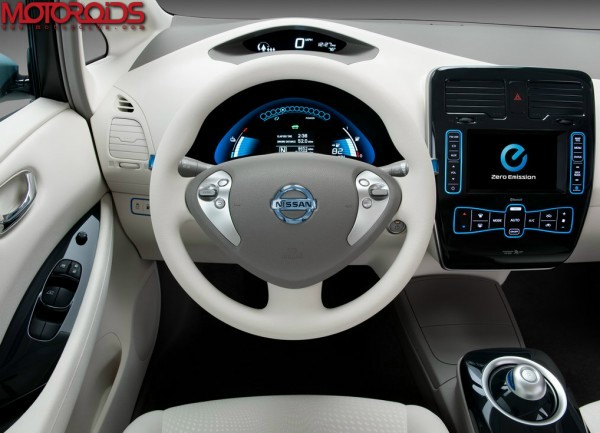
While there is still some time before the Leaf is introduced in India, the car is selling successfully in North America, Japan and European countries where an EV re-charging infrastructure has been established. Nissan is waiting for the EV charging infrastructure to develop in India before it makes the car commercially available in the region.
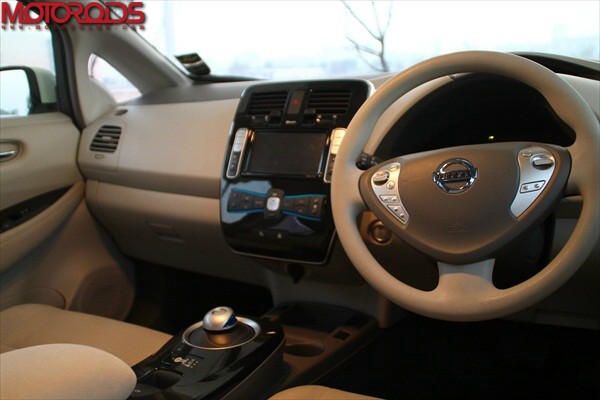
Developed by the Automotive Energy Supply Corporation (AESC), a joint venture between Nissan and NEC, LEAF’s advanced lithium-ion battery has the capacity to store twice as much energy as the previous generation. Nissan LEAF has 48 lithium-ion battery modules with four battery cells inside each module which fit snugly beneath the floor of the car, thus optimising cabin space and providing a low centre of gravity for a smooth and stable ride.
Responsive performance comes from the 80kw (108 bhp) electric motor that generates its maximum 280 Nm of torque – equivalent to the torque of a conventional 3.0-litre V6 petrol engine ¬– from a standing start. The result is rapid acceleration perfectly in tune with the Nissan LEAF’s natural urban and suburban habitat.
LEAF sits on a generous 2700 mm wheelbase, is 4445 mm long, 1770 mm wide and 1550 mm tall. Because its electric motor is physically small and the compact battery packs are located under the floor towards the centre of the chassis.
The result is a low-slung front-end which is dramatically framed by the vertical blue LED headlights. These also direct airflow away from the door mirrors to improve Nissan LEAF’s aerodynamics.
The body was created using Nissan’s ‘smart fluidity’ principle, combining flowing lines with aerodynamic efficiency. The kicked-up roofline blends into a large spoiler while LEAF’s wind cheating shape is further helped by the flat, smooth underfloor.
The rear view is dominated by thin, gently curved, vertical taillights and is, of course, notable by the total absence of an exhaust pipe.
Inside there’s ample space for five adults and the airy interior houses advanced electronic devices including a flat centre cluster for the bespoke IT system and a neat and easy to use gearshift selector inspired by a computer mouse.
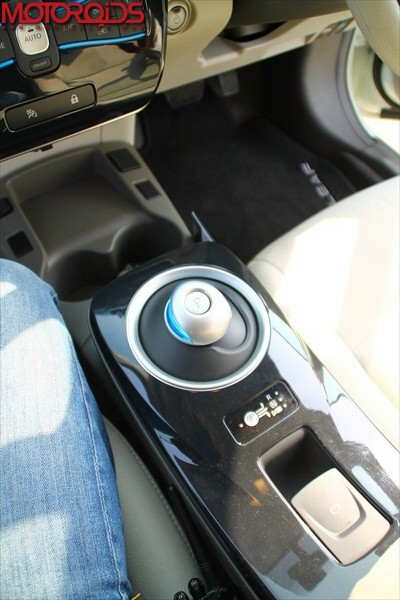
Nissan LEAF is easy to drive. The electric powertrain does not idle and only rotates when the vehicle is moving. To start the engine, the driver presses the start button, and electricity is ready to flow to the motor. Using the electric shift, the driver then selects “D”, and the vehicle starts to move. It’s that simple.
A full charge delivers a potential range of 175 km as tested over the New European Driving Cycle (NEDC). Global research indicates that the average daily mileage for 80 per cent of the world’s population is under 100 kms: the figure in Japan and the UK is under 50 kms for 80 per cent of the population.
Driving range depends on several factors, including external temperature, air-conditioning usage, battery age and driving style. An onboard screen shows key battery data, including maximum driving range, power output and regenerated electricity. An eco-indicator on the meter displays the status of electricity consumption, giving real-time feedback on the driver’s performance.
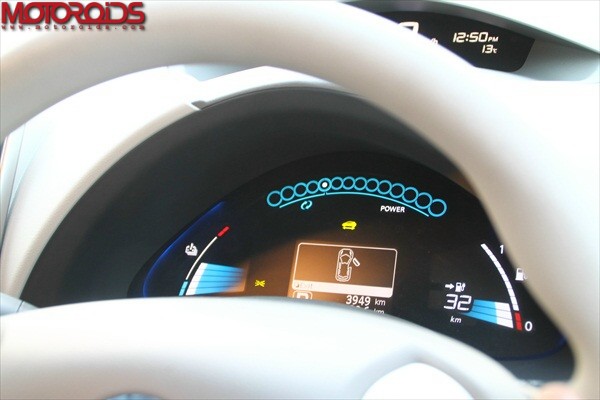
A regenerative braking system helps to increase the vehicle’s range. By applying the brake or lifting off the accelerator, the electric motor acts as a generator, converting energy that would otherwise be wasted into battery energy. To increase regenerative braking capability, there’s a driver-controlled Eco mode setting, which also can be used to reduce air conditioning and thus improve driving range by 10 per cent when driving in urban areas.
Standard equipment is comprehensive – it includes air conditioning, satellite navigation and a rear-view parking camera – so the only optional extra is a solar panel integrated into the rear spoiler which can harvest energy from the sun to power accessories.
Using a domestic electricity supply, LEAF can be recharged to full capacity overnight, but there is also the potential to ‘Quick Charge’ the car, using a new QC charger developed by Nissan. This can deliver up to 50 kW of high voltage direct current to recharge up to 80 per cent of the battery capacity in just 30 minutes.
Thanks to the low centre of gravity, handling and ride comfort are exceptional while the rapid progress is accompanied by an almost complete lack of noise.
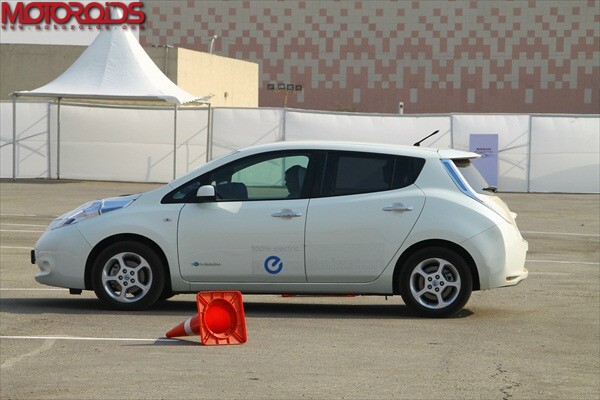
This whisper-quiet performance could pose a problem in city traffic so to alert pedestrians to LEAF’s presence a sine-wave sound system has been developed. This sweeps from 2.5kHz at the high end to a low of 600Hz, an easily audible range across age groups. The system operates when Nissan LEAF is driven under 25km/h and cuts out over 30km/h.
Other safety systems include airbags, ABS, Brake Assist, Vehicle Dynamic Control and pretensioner seatbelts as standard, along with a rear-view camera for safe and easy parking. These features, plus Nissan’s efforts to protect the batteries and isolate the electrical system in the event of a serious accident, helped LEAF take a top five star rating in the tough Euro NCAP safety tests
Here’s the detailed features list of the car, followed by the image gallery
Battery
• 80 kW AC synchronous motor
• 24 kWh lithium-ion battery
• Quick Charge Port
Brakes
• 4-wheel power-assisted vented disc brakes
• regenerative braking system
• 4-wheel Anti-lock Braking System (ABS)
• Electronic Brake force Distribution (EBD)
• Brake Assist (BA)
• Electronic parking brake
Suspension and steering
• Independent strut front suspension with stabilizer bar
• Torsion bar rear axle with integrated stabilizer bar
• Vehicle-speed-sensitive electric power steering
Wheels and tyres
• 16″ 5-spoke aluminum-alloy wheels
• P205/55R16 all-season tires
• tire repair kit4
Interior Features
• 5-passenger seating capacity
• 6-way manual adjustable driver’s seat
• 4-way manual adjustable front passenger’s seat
• front and rear heated seats
• 60/40-split fold-down rear seats
• partially recycled light gray cloth seat fabric6
• front center armrest with storage
• heated 3-spoke steering wheel
• palm-shift drive selector
• Nissan Intelligent Key and Push Button Start
• Bluetooth™ Hands-free Phone System
• Automatic Temperature Control (ATC)
• rear seat heat duct
• trip computer
• remote keyless entry
• power door locks with auto-locking feature
• power windows with driver’s one touch auto up/down feature
• auto-dimming rearview mirror
• tilt steering column
• cruise control with steering wheel-mounted controls
• variable intermittent windshield wipers
• rear intermittent wiper with washer
• rear window defroster
• 2 front map lights
• front door pockets
• center console storage
• dual sun visors
• dual visor vanity mirrors
• front and rear assist grips
• 2 cup holders
• illuminated glove compartment
• auxiliary 12-volt DC power outlet
• cargo cover
• HomeLink Universal Transceiver
• auxiliary audio input jack8
• USB connection port for iPod® interface and other compatible devices8
• 6 speakers
• steering wheel-mounted audio controls
• fixed roof antenna with blue accent
• telematics
• Nissan Navigation System with 7.0″ color display
• XM® NavTraffic
• CARWINGS™ connect to Nissan LEAF™ to
• monitor battery state of charge/charging status
• start vehicle charging event
• activate heating and air conditioning systems
Safety
• Nissan Advanced Air Bag System with dual-stage supplemental front air bags with seat-belt and occupant-classification sensors 9
• driver and front-passenger seat-mounted side-impact supplemental air bags 9
• roof-mounted curtain side-impact supplemental air bags for front and rear-seat outboard occupant head protection9
• Vehicle Dynamic Control (VDC)10 with Traction Control System (TCS)
• 3-point seat belts for all seating positions
• front seat belts with pretensioners and load limiters
• LATCH System (Lower Anchors and Tethers for CHildren)
• front-seat height-adjustable headrests
• rear-seat height-adjustable headrests
• energy-absorbing steering column
• zone body construction with front and rear crumple zones
• Tire Pressure Monitoring System (TPMS)
Security
• Nissan vehicle immobilizer system
• vehicle security system
